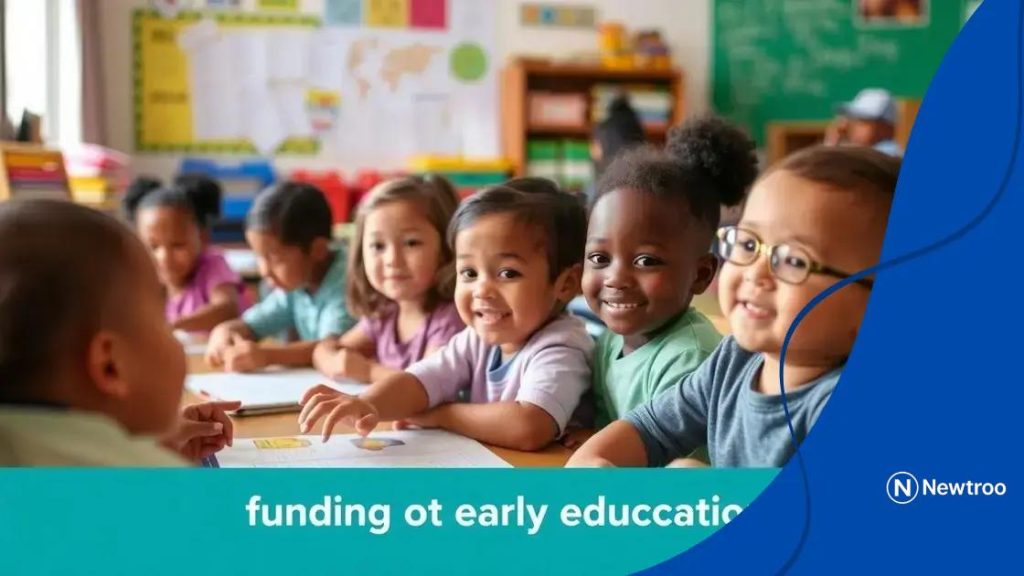Early education funding updates announced for better resources

Anúncios
Early education funding updates announced increase access to quality programs, reduce costs for families, and support diverse learning needs, enhancing educational opportunities for children.
Early education funding updates announced are creating buzz among educators and parents alike. Have you wondered what these changes could mean for your child’s learning environment? Let’s dive into the details!
Anúncios
Current state of early education funding
The current state of early education funding is a critical topic that affects many families and communities. Understanding how these funds are allocated can help parents and educators make informed decisions for their children.
Overview of Funding Sources
Funding for early education comes from various sources, including state and federal governments, as well as private organizations. Each state has its own policies regarding funding, which can lead to significant differences in the quality of education provided.
- Federal programs like Head Start provide essential funds.
- State budgets impact local education funding levels.
- Private donations can enhance educational resources.
In many areas, funding can be a challenge. Schools often struggle with limited budgets that affect hiring qualified staff and purchasing necessary materials. This situation can lead to larger class sizes and less individual attention for children.
Anúncios
Recent Trends in Funding
Recently, there has been a growing emphasis on increasing funding for early education programs. Policymakers are recognizing the long-term benefits of investing in early childhood education, which can lead to better outcomes for children.
- New initiatives aim to improve access to quality programs.
- Increased awareness about the importance of early development.
- Advocacy groups are pushing for more equitable funding.
Investing in early education is seen as a way to not only support children’s development but also to provide financial savings in the long run. Programs that receive adequate funding can help to reduce later costs associated with remediation and social services.
As discussions about funding continue, it’s essential for communities to stay informed about these changes. Keeping up to date can empower parents and educators to advocate for better resources and support systems for our youngest learners.
Key changes in funding policy
Understanding the key changes in funding policy is essential for grasping how early education can improve. These changes directly influence the resources available for children and educators.
New Funding Initiatives
Recently, several new initiatives have been introduced aimed at increasing the amount of funding for early education. These initiatives are designed to create more opportunities for children to access quality programs.
- Expansion of state-funded pre-K programs.
- Introduction of grants for low-income families.
- Incentives for schools to improve their facilities.
These initiatives not only boost funding but also encourage collaboration between different stakeholders. Schools, local governments, and non-profits are coming together to ensure that every child has access to essential learning resources.
Focus on Equity
A significant shift in funding policy is the focus on equity. Policymakers are now prioritizing resources for underserved communities. The idea is to level the playing field so that all children have similar opportunities to succeed.
- Increased funding for rural and low-income areas.
- Targeted support for diverse populations.
- Implementation of programs that address specific community needs.
As funding policies evolve, they aim to address these inequities and ensure that every child can thrive in a quality educational environment. Awareness of these key changes allows parents and educators to better advocate for necessary resources.
Impact of funding on early childhood programs

The impact of funding on early childhood programs is significant and multifaceted. Understanding how funding influences these programs helps stakeholders recognize the value of financial support.
Quality of Education
Increased funding directly enhances the quality of education provided to young children. More resources allow for better training for teachers and improved learning materials that can engage young minds effectively.
- Smaller class sizes lead to more individualized attention.
- Enhanced curriculum development can improve learning outcomes.
- Access to advanced technology fosters creativity and learning.
When programs receive adequate funding, educational environments become more enriching and supportive. This leads to better overall outcomes for children in their formative years.
Accessibility and Inclusion
Funding also plays a critical role in making early childhood programs accessible to all children, particularly those from low-income families. Grants and subsidies can help eliminate barriers that prevent families from enrolling their children in quality programs.
- Financial aid helps families afford tuition costs.
- Resources ensure programs are inclusive for all children.
- Transportation assistance can enhance participation rates.
By allocating funds strategically, programs can ensure that every child has the opportunity to thrive. This inclusivity fosters diversity, which is essential for a well-rounded educational experience.
Future projections for education budgets
Future projections for education budgets indicate important trends that can shape the landscape of early childhood education. As policymakers assess funding needs, they look ahead to ensure resources align with the growing demands of educational programs.
Increased Investment
Many experts believe that there will be an increased investment in education as communities recognize the value of early learning. This is driven by research showing that strong early education correlates with long-term benefits for children and society.
- Proposals for higher funding levels are being discussed.
- More emphasis is placed on early childhood outcomes in budget considerations.
- Public support for education initiatives is growing.
As a result, we may see more states and localities prioritizing early childhood education funding in their upcoming budgets.
Impact of Economic Trends
The economy can greatly influence education budgets. Economic growth can lead to increased tax revenues, which in turn can enhance funding for education programs. Conversely, economic downturns might threaten funding levels, requiring careful planning to mitigate impacts on early education.
- Assessments are being conducted to predict budget fluctuations.
- Stakeholders are pushing for sustainable funding models.
- Emergency funds may be established to protect against downturns.
Anticipating these changes helps educators and parents prepare for potential shifts in available resources. Projections indicate that strategic planning and advocacy will be crucial for maintaining support for early childhood education.
How parents can benefit from these updates
Parents can significantly benefit from the updates in early education funding. These changes bring new opportunities that positively impact their children’s development and learning environments.
Access to Quality Programs
With increased funding, more high-quality early education programs become available. This means that parents have greater choices for their children, ensuring they can enroll in programs that meet their standards and expectations.
- Expanded access to local preschools makes attendance easier.
- Programs often provide enhanced learning materials and qualified staff.
- Increased funding may lead to reduced tuition costs for families.
Such access helps children receive the early developmental support they need to thrive in their educational journey.
Support for Diverse Needs
The updates often include provisions for children with diverse needs. This means that parents can find programs catering to various learning styles and requirements, which is crucial for fostering an inclusive environment.
- Programs may offer specialized resources for children with disabilities.
- Diverse curricula encourage cultural awareness and acceptance.
- Parent involvement programs might be enhanced, offering support and education.
By acknowledging and addressing these diverse needs, early education becomes more beneficial for all children in the community. Parents can feel reassured that their children will receive the appropriate support necessary for their development.
FAQ – Frequently Asked Questions about Early Education Funding Updates
How do updates in early education funding affect my child’s education?
Updates in funding provide access to higher quality programs and resources, enhancing your child’s learning experience.
What benefits do parents receive from these funding updates?
Parents can benefit from reduced tuition costs, improved program quality, and increased support for diverse learning needs.
Are there opportunities for parents to get involved in their child’s education?
Yes, many updated programs offer ways for parents to engage and advocate for their children’s educational experiences.
How can I stay informed about changes in education funding?
Staying informed can involve following local education news, joining parent organizations, and participating in community discussions.